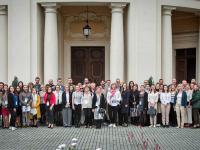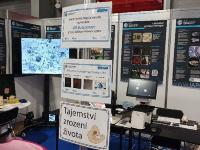
News and Updates
The 30th Jubilee Symposium on Biology and Immunology of Reproduction (SBIR 2025) took place from October 5–7, 2025, in the elegant setting of Liblice Castle. This traditional interdisciplinary conference brings together experts from the fields of reproductive biology, immunology, medicine, and related sciences. One of the main organizers of this year’s edition was Assoc. Prof. Kateřina Komrsková ( Institute of Biotechnology, Czech Academy of Sciences), head of a research group within the ART of the Future project under the Strategy AV21 programme, under whose auspices the conference was held.
Starting in September this year, a new master’s student, Anna Kolesnik, will join the Future of Assisted Reproduction (ART) project (AV21 Strategy). Anna is enrolled in the Reproductive and Developmental Biology program at the Faculty of Science, Charles University. In her master’s thesis, she will focus on the study of the spindle apparatus in early embryos.
The fourth year of the Science in Action summer school brought 17 students from nearby schools to Liběchov. A week full of lectures, laboratory practicals, and excursions introduced them to the world of science – from assisted reproduction and biomedical research on minipigs to exploring nature in the field. Special attention was given to the topic of assisted reproduction within the AV21 Strategy project – The Future of ART.
Researchers at the Institute of Animal Physiology and Genetics of the Czech Academy of Sciences have described a previously unknown but crucial role of the gene CDK12 in oocyte maturation and fertility. Until now, this gene had been primarily associated with breast and ovarian cancers. However, their latest study demonstrates that removal of this gene in oocytes leads to complete infertility in female mice due to ovarian failure. The loss of CDK12 in oocytes also causes physiological changes in the ovaries. As a result of disrupted folliculogenesis – the proper development and ovulation of oocytes – the ovaries shrink overall. The findings suggest a similar role of this gene in human oocytes as well.
From June 5–7, 2025, the annual Science Fair, the largest public outreach event of the Czech Academy of Sciences, took place in Prague–Letňany. At the booth of the Institute of Animal Physiology and Genetics (ÚŽFG), we presented the new AV21 Strategy project Future of Assisted Reproduction (ART), coordinated by our institute. With this initiative, the Academy of Sciences responds to the global reproduction crisis by linking cutting-edge basic research in ART with the practice of reproductive clinics.
From May 29 to June 2, 2025, a practical course on Experimental Work with Mammalian Oocytes and Embryos was held for master’s students of the Reproductive and Developmental Biology program at the Faculty of Science, Charles University. The aim of the course was to introduce students to techniques of isolating and cultivating mammalian oocytes and early embryos in vitro, as well as to the basics of live-cell microscopy.
Since January 2025, the Institute of Animal Physiology and Genetics of the Czech Academy of Sciences (IAPG) has been coordinating an ambitious research program, ART – The Future of Assisted Reproduction, which bridges cutting-edge academic research with clinical practice in the field of assisted reproduction.













